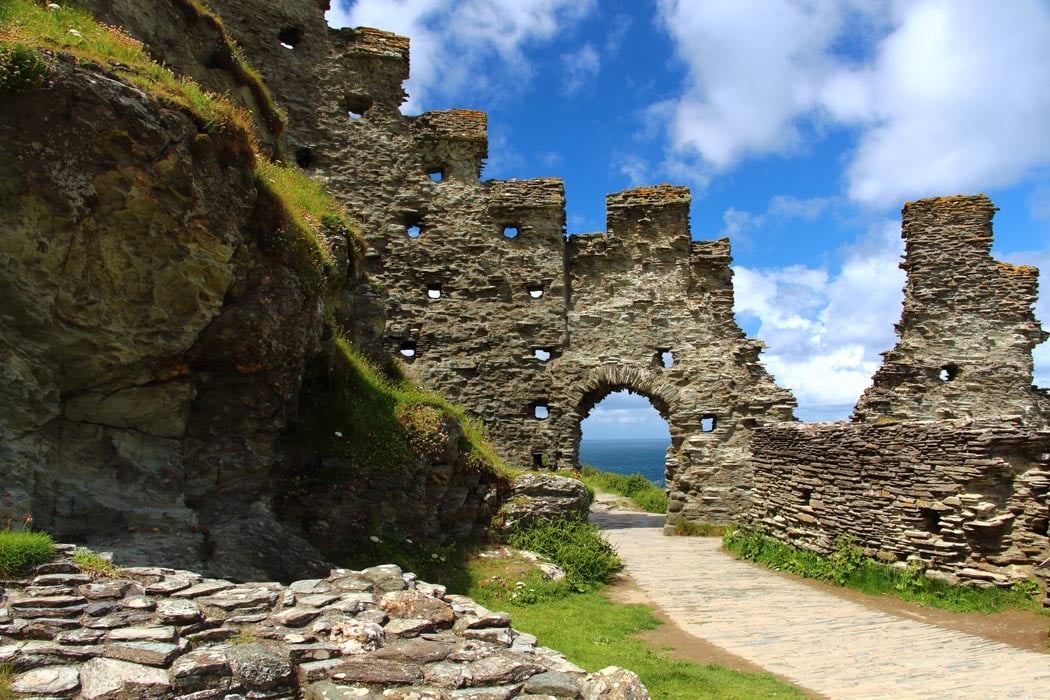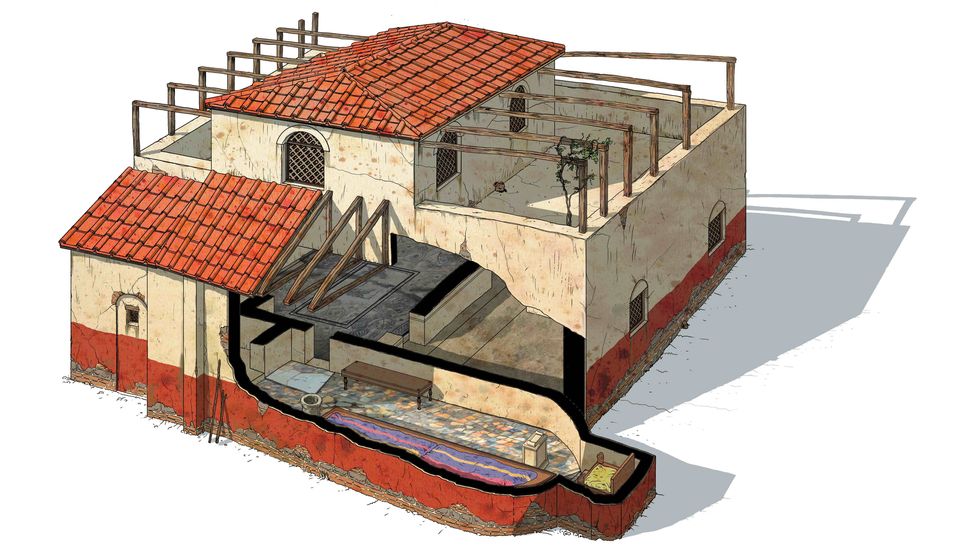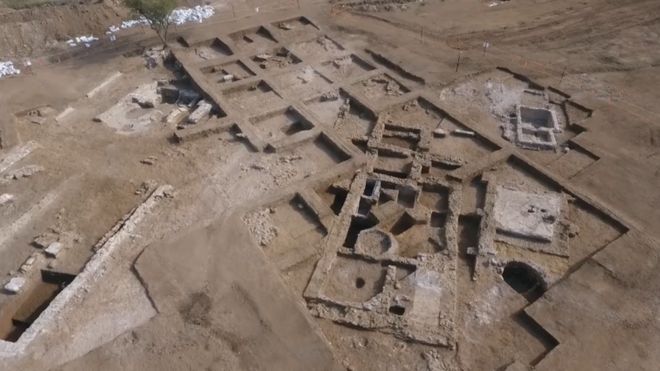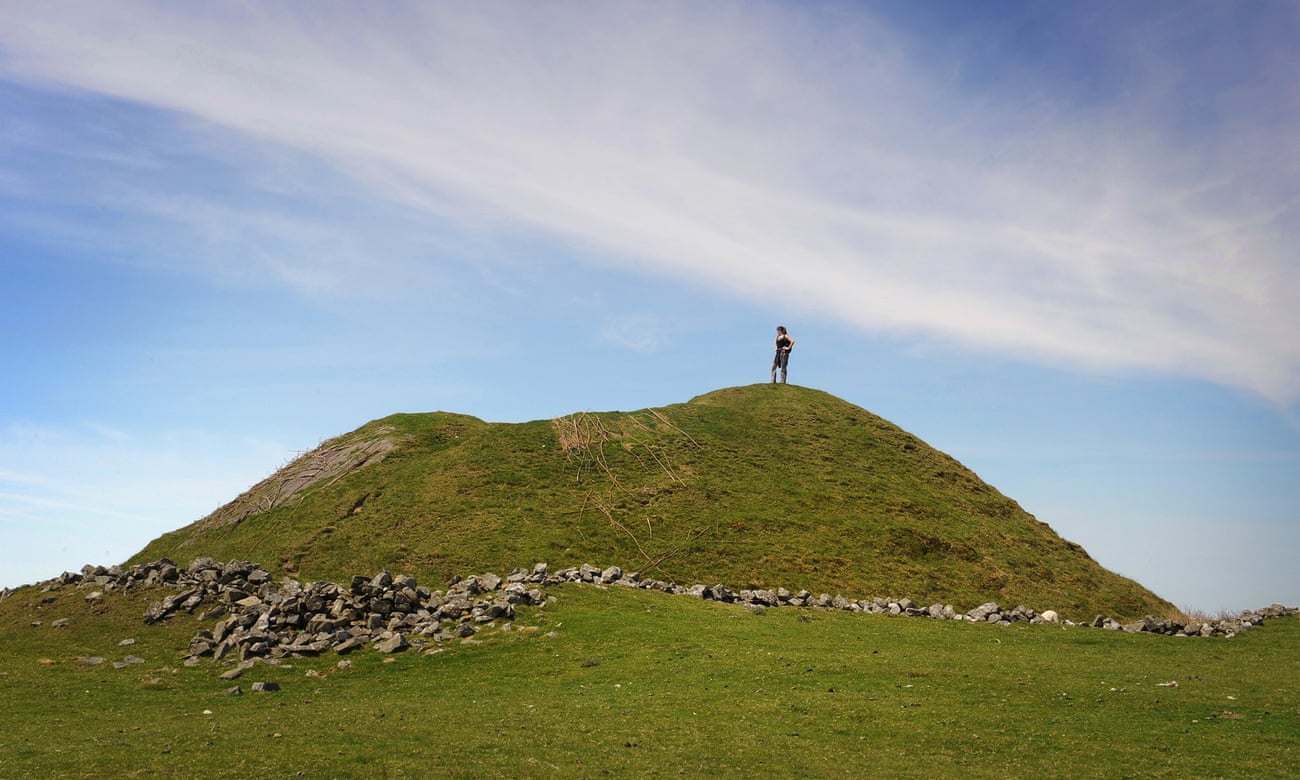The Roman Archaeology Blog is concerned with news reports featuring Roman period archaeology. If you wish to see news reports for general European archaeology, please go to The Archaeology of Europe Weblog.
Thursday, December 19, 2019
Tintagel Castle: Arthurian Legend Mixes with True History
Tintagel Castle is a site of castle ruins located on Tintagel Island; a peninsula connected to the North Cornwall coast in England by a narrow strip of land. This castle was an important stronghold from around the end of Roman rule in Britain, i.e. the 4th century AD or the 5th century AD until the end of the 7th century AD. Tintagel Castle is best known for the claim that it was the place where the legendary King Arthur was conceived, but the real history of the site is also exciting.
Signs of the Romans at Tintagel Castle
The site where Tintagel Castle stands today is likely to have been occupied during the Roman era, as artifacts dating to this period have been found on the peninsula. Having said that, as structures dating to the Roman period have yet to be discovered, it is not entirely clear if Tintagel Island was inhabited during the Roman period.
It may be said with more certainty that the site was occupied between the end of the Roman period and the 7th century AD. In 2016, geophysical surveys revealed the existence of walls and layers of buildings at the site. Excavations yielded walls, said to belong to a palace, a meter in thickness.
Read the rest of this article...
Here come the sundials! Prof uncovers eight ‘hidden’ sundials in ancient mosaics
Professor Marek Olszewski noticed a previously unknown depiction of sundial in Madaba Map, a great mosaic located in Jordan. The sundial is located next to the gate on the left.
Credit Wikipedia/public domain
Credit Wikipedia/public domain
A university professor studying ancient mosaics has discovered eight previously unknown sundials in the designs, taking the total number known number to 15.
Professor Marek T. Olszewski from the University of Warsaw was re-examining a number of mosaics dating back to the 2nd century AD when he made his startling discovery.
One of the mosaics from the 6th century AD which was discovered by the Gate of Damascus in Jerusalem, Olszewski noticed that between a richly dressed women, a mysterious object is visible, which scientists at the beginning of the 20th century described as an oil lamp or column.
Olszewski said: ”After careful analysis and comparison with a sundial discovered during excavations, I came to the conclusion that this mosaic and other ones similar to it depict sundials.”
Read the rest of this article...
Dazzling 'Temple of Colored Marbles' Honoring Roman God Discovered in Italy
In this reconstruction of the "Mithraeum of Colored Marbles" the spelaeum, the most important room in the mithraeum, is shown on the bottom level.
(Image: © G. Albertini)
Some 1,600 years ago, ancient Romans would have worshipped the god Mithras, possibly in an altered state of consciousness, within the "Mithraeum of Colored Marbles," said archaeologists who found the remains of this temple in Ostia, Italy.
Artifacts and inscriptions found in the mithraeum suggest that the worshippers venerated both Mithras, a popular god in the Roman Empire, and other gods.
Read the rest of this article...
Israelis find rare Roman fish sauce factory
The site is one of the few in the eastern Mediterranean
Image copyright ISRAEL ANTIQUITY AUTHORITY
Israeli archaeologists have discovered the well-preserved remains of a 2,000-year-old factory for making garum, the fabled fish sauce that the Romans took with them on all their journeys of conquest.
The Israel Antiquities Authority came across the small cetaria, or factory for making the prized sauce, while inspecting the site of a planned sports park on the outskirts of the southern city of Ashkelon, Israel's Kan public broadcaster reports.
The dig was funded by the local authorities, and young people and school children from the Ashkelon area came to help out.
It is one of the very few garum factories found in the eastern Mediterranean, despite the Romans' long presence in the area and the premium they put on the pungent fermented sauce.
Read the rest of this article...
Saturday, December 14, 2019
Roman remains: a walk through history in Snowdonia
Hold that fort … Tomen y Mur was built to control local tribes in AD78
Medieval Welsh mythology and Roman history collide and come to life at the Tomen y Mur hill fort
Wherever you walk in Wales, it turns out that you’re tracking some ancient, mythic storyline or other – and nowhere more so than at Tomen y Mur (“the mound on the wall”), a Roman fort and amphitheatre in Snowdonia national park, which sits beside a crossing of four Roman roads.
Tomen y Mur, surprisingly unsignposted in spite of its significance, sits on the lower slopes of Mynydd Maentwrog, not far from the A470 to the north-east of Llyn Trawsfynydd reservoir. The fort, now a scheduled monument, was constructed under governor Gnaeus Julius Agricola in 78AD, as part of his campaign to control the native Ordovices, a Celtic tribe who resisted Roman rule with some enthusiasm. Agricola’s response was a brutal campaign which, according to Roman chronicler (and Agricola’s son-in-law) Tacitus, almost wiped out the tribe.
Read the rest of this article...
Ancient wonders: five little-known archaeological sites in the UK
Mên-an-Tol, known locally as the Crick Stone, in Cornwall England.
Photograph: Paul Williams/Alamy
Our landscape is studded with reminders of past peoples. An expert in the field chooses her favourite windows into antiquity
Mên-an-Tol, Penwith Moor, near Madron, Cornwall
The name means “stone with a hole” in Cornish and the site is probably about 4,000 years old, dating from the bronze age. There are more stones hidden under the turf. What’s clear is that you’re in an ancient landscape – there’s a neolithic enclosure on the hillside, bronze-age barrow burials and the Boskednan Nine Maidens stone circle nearby. Some 400 metres to the north of the Mên-an-Tol is the Mên Scryfa, probably a bronze-age standing stone that was reused some time between 450-650AD as a grave marker. It’s inscribed with RIALOBRANI CVNOVALI FILI in Roman lettering, meaning “Rialobranus, son of Cunovalus”. Rialobran, or Ryalvran, is a native Cornish name, and may mean “royal raven”.
Thursday, December 12, 2019
Savvy Sonar Tech Uncovers Enormous Roman Shipwreck Off Greece
Sonar technology has been used to identify one of the biggest Roman shipwreck ever found in the Mediterranean Sea. It is believed that the vessel lay at the bottom of the seabed for 2000 years.
The wreck was located off the Greek island of Kefalonia, between 2013 and 2014 during “an underwater natural and cultural heritage assessment survey,” reports the Journal of Archaeological Science . It was found not far from the fishing port of Fiskardo. The shipwreck has been named after the village as it is now called the ‘Fiskardo shipwreck’.
Savvy Sonar Technology
During the survey, side-scan sonar detection technology was used by a Greek team to identify the ancient vessel on the seabed. This form of sonar technology can generate images of the seafloor, and it “works by beaming out high-frequency sound pulses in a wide fan shape from a boat floating on the surface,” reports The Daily Mail . When these pulses strike objects on the floor, they provide data that can be used to create a model of the seabed.
his type of sonar technology can differentiate shipwrecks from other objects and features, even if they have similar sonic signatures, which means that it’s very popular with marine archaeologists. The Greek team also found two World War II wrecks in the same general area, which evidences the effectiveness of the technology used.
Read the rest of this article...
NEWLY FOUND 1ST CENTURY BC ROMAN FORT, CUSTOMS PUSH BACK FOUNDING ALMUS FORTRESS IN BULGARIA’S DANUBE TOWN OF LOM
The first Ancient Roman fortification in Almus, today’s Lom on the Danube, was built in the middle of the 1st century AD, as per the latest discoveries.
Photo: Lom Museum of History Facebook Page
An Early Roman fort from the 1st century AD has been discovered in the Ancient Roman city of Almus in today’s town of Lom on the Danube in Northwest Bulgaria, demonstrating that the first Roman fortifications on the site were built substantially earlier than previously known.
The main Almus Fortress is known to have been built in the 3rd – 4th century, during the reigns of Roman Emperors Diocletian (r. 284-305 AD) and Constantine the Great (r. 306-337 AD).
However, during the 2019 excavations of the Roman city of Almus in the early fall, the Bulgarian archaeologists have discovered archaeological layers dating as early as the second half of the 1st century AD.
In them, they have found part of an Early Roman fortress wall, a street with a canal, a destroyed barracks that housed a contubernium, the smallest unit of soldiers in the Roman army, and a luxury building, which may have been used as customs, reports local news site MediaNews.
Inside the destroyed contubernium barracks, the archaeologists have discovered a gold phalera – an Ancient Roman decoration awarded as a medal to military officers.
Read the rest of this article...
Tuesday, December 10, 2019
The art of the Roman surveyors emerges from newly discovered pavements in Pompeii
IMAGE: PLAN OF THE HOUSE OF ORION, SHOWING THE DISPOSITION OF THE NEWLY DISCOVERED IMAGES (1,2) AND OF THE MOSAICS (3)
The technical skills of the Roman agrimensores - the technicians in charge of the centuriations (division of the lands) and of other surveys such as planning towns and aqueducts - are simply legendary. For instance, extremely accurate projects of centuriations are still visible today in Italy and in other Mediterranean countries. Their work had also religious and symbolic connections being related with the foundation of towns and the Etruscan's tradition.
These technicians were called Gromatics due to their chief working instrument, called Groma. It was based on a cross made of four perpendicular arms each bringing cords with identical weights, acting as plumb-lines. The surveyor could align with extreme precision two opposite, very thin plumb-lines with reference poles held at various distances by assistants or fixed in the terrain, in the same manner as palines (red and white posts) are used in modern theodolite surveying.
Read the rest of this article...
Roman villa unearthed in southern England
Credit: Bournemouth University
A well preserved Roman villa has been rediscovered at the Dorset Wildlife Trust nature reserve, Nunnery Mead, near Frampton.
The dig was carried out by experts from Bournemouth University. Thought to be destroyed in the mid-nineteenth century, the team were delighted to find a well-preserved site.
Dr Miles Russell, Senior Lecturer in Prehistoric and Roman Archaeology Department of Archaeology and Anthropology Faculty of Science and Technology Bournemouth University, said: “The opportunity to survey, record and better understand the Roman villa at Nunnery Mead, Frampton, was one we couldn’t miss, given that the building was thought to have been destroyed in the mid-19th century.
Read the rest of this article...
Roman shipwreck from time of Jesus Christ found with 'exciting' cargo on board
Researchers believe the ship to have been in operation between the first century BC
and the first century AD
A Roman shipwreck dating back to the time of Jesus Christ has been found in a huge archaeological breakthrough.
It was discovered off the coast of a Greek island - and it had some unexpected cargo on board.
The boat was being held down with jugs used to store wine and food, it has been claimed.
The well-preserved containers, known as amphorae, were probably carrying olive oil and grains as well.
The jars have been analysed by experts who determined when they were used by the Greeks and the Romans.
The vessel is understood to measure 34m in length and 13m in width.
Read the rest of this article...
Monday, December 9, 2019
Archaeological Study Tour to Orkney
EMAS Study Tour to Orkney
14 – 23 April 2020
There are still a few places left on the EMAS Archaeological Society Study Tour to Orkney.However, hotel places are very limited, so an early reply is advised.
You can find further details on the EMAS website.
Further details...
Roman silver coin hoard found in Switzerland
Hoard of silver denarii found near Pratteln, Switzerland
[Credit: Nicole Gebhard, Archaeology Baselland]
A Roman treasure of 293 silver coins has been discovered in a forest near Pratteln in northwestern Switzerland. The find is one of the largest Roman silver hoards in Switzerland. The coins are exclusively denarii, which according to information from Archaologie Baselland are in very good overall condition. A volunteer from Archaologie Baselland found the hoard in the summer of 2019 on the slope of the Adlerberge near Pratteln Baselland.
The oldest coin was struck under Emperor Nero, who reigned between AD 54 and 68. Most of the coins date from the second century, the most recent from the time of Emperor Commodus - they were struck in Rome in AD 181/182.
According to the communique, the find is second largest assemblage Roman silver coin hoards in Switzerland, after the treasure of Augusta Raurica (Kaiseraugst) discovered in the immediate vicinity.
Read the rest of this article...
Saturday, December 7, 2019
Floor pavements in Pompeii illustrate surveying technology
Decorative pavements in the floor of a recently unearthed Roman house in Pompeii offer a glimpse into the life and work of an ancient land surveyor. The pavements depict a stylized drawing of an ancient surveyor’s tool called a groma, along with a diagram of a surveying technique and the plan of a construction project in Pompeii. So far, they’re the only original Roman illustrations of the tools and techniques the Romans used to help build an empire and its infrastructure.
The land surveyor’s house
Only a few metal fragments of a Roman groma exist today (also recovered from Pompeii), and archaeologists have found only a few images carved into surveyors’ tombstones. Otherwise, we know the tool only from descriptions in medieval versions of ancient Roman surveying manuals.
The newly unearthed pavements at Pompeii suggest that those medieval copies were pretty close to the original ancient texts. An image on the floor of the entrance hall is nearly identical to illustrations in medieval copies of Roman texts, attributed to Roman surveyor Hygius and famed architect Vitruvius.
Colored tiles laid into the crushed terracotta pavement depict a circle with a square drawn inside. Lines divide the square into eight equal sections. In Hygius’ and Vitruvius’ texts, the image illustrates how to orient a building to one of the cardinal directions. On the floor of the house, the image shows how the house is oriented in relation to the four cardinal directions: one of the lines points along the length of the house, which faces northeast. Meanwhile, the corners of the square point north, south, east, and west.
Read the rest of this article...
Londinium Romans’ blood lead levels so high they may have lowered birth rates
A team of archaeologists and health scientists has found that lead poisoning could have afflicted city dwellers in Londinium, the Roman settlement on the site of modern London, during the Roman occupation of ancient Britain.1 The levels of lead they found in Londinium Roman bones were so high that they would have exceeded limits considered toxic.
Environmental health scientist Sean Scott of the University of Wisconsin-Madison and colleagues found that lead levels in bones taken from three cemeteries in Londinium may be more than 70 times higher than those in remains from pre-Roman Iron Age Britain. And an analysis of the lead isotope composition fits with that seen previously in Roman-age lead pollution in Britain. The researchers say that the lead levels are high enough to have had a possible effect on health, perhaps even reducing birth rates.
Lead pollution during Roman times has been demonstrated previously,2 but generally has been associated with lead mining. It hasn’t been clear whether serious lead pollution could have afflicted ordinary citizens in Roman urban settlements.
'Only complete' 1,700-year-old Roman egg at Aylesbury dig
This egg was cast into a watery pit, possibly as part of a Roman funeral rite
OXFORD ARCHAEOLOGY
The only complete chicken's egg from Roman Britain is a "genuinely unique discovery", according to an expert.
It was one of four hen's eggs found during a dig in Aylesbury, Buckinghamshire, although three broke releasing a "potent stench".
The "remarkable collection" of other organic finds included leather shoes, wooden tools and a "very rare" basket.
Archaeologist Edward Biddulph said the extent and range of discoveries "was more than could be foreseen".
Read the rest of this article...
Thursday, December 5, 2019
Roman Secret Society Lodge Discovered in Pompeii
Stone and tile diagrams in an ancient Pompeii building have been linked to Roman surveyors and their sophisticated measuring tools and highly guarded secret craft.
Ancient Roman measuring specialists and town planners, known as ‘agrimensores’ used smart measuring instruments and these newly discovered images in the Casa di Orione, or the House of Orion, in the province of Naples, southern Italy, depict these mysterious tools. And furthermore, this location is believed to have been used by the measuring specialists as a center of their planning and measuring activities.
Examining the House of Orion
Details of the ancient floors found in the house of Pompeii have been published in a paper by Massimo Osanna, director of the Pompeii archaeological site, and Luisa Ferro and Giulio Magli, of the School of Architecture at the Politecnico of Milan.
The Great Pompeii Project, an EU-backed initiative to restore the ancient Italian city, stated that a small section of the House of Orion had been excavated between 1892 and 1893, but the greater house was only discovered in December last year. And now, researchers believe their excavations have uncovered the first ever depiction of the “groma”, a clever measuring tool developed in ancient Egypt and later used by Greek then Roman land surveyors.
Read the rest of this article...
Long-distance timber trade underpinned the Roman Empire's construction
Some of the oak planks in situ in the foundation of the portico
[Credit: Bernabei at al., 2019]
The timber requirements of ancient Rome were immense and complex, with different types of trees from various locations around the Roman Empire and beyond used for many purposes, including construction, shipbuilding and firewood. Unfortunately, the timber trade in ancient Rome is poorly understood, as little wood has been found in a state adequate for analysis. In this study, Bernabei et al successfully date and determine the origin and chronology of unusually well-preserved ancient Roman timber samples.
The twenty-four oak timber planks (Quercus species) analyzed in this study were excavated during Metro construction in Rome during 2014-2016. They formed part of a Roman portico in the gardens of via Sannio (belonging to what was once a lavishly decorated and rich property). The authors measured the tree-ring widths for each plank and ran statistical tests to determine average chronology, successfully dating thirteen of the planks.
By comparing their dated planks to Mediterranean and central European oak reference chronologies, the authors found that the oaks used for the Roman portico planks were taken from the Jura mountains in eastern France, over 1700km away. Based on the sapwood present in 8 of the thirteen samples, the authors were able to narrow the date these oaks were felled to between 40 and 60 CE and determined that the planks all came from neighboring trees. Given the timber's dimensions and the vast distance it travelled, the authors suggest that ancient Romans (or their traders) likely floated the timber down the Saône and Rhône rivers in present-day France before transporting it over the Mediterranean Sea and then up the river Tiber to Rome, though this cannot be confirmed.
Wednesday, December 4, 2019
UNKNOWN CHAINMAIL ARMORS DISCOVERED IN ROMAN COLONY DEULTUM NEAR BULGARIA’S BLACK SEA COAST
Two or three chainmail armors from the Late Antiquity previously unseen in Bulgaria have been discovered in the ancient and medieval city of Deultum close to the Black Sea coast.
Photo: Desant
An unknown type of well-preserved Late Antiquity chainmail armors from the last years of the Roman Empire before its division or the early Eastern Roman Empire, i.e. Byzantium, have been discovered by archaeologists in the Ancient Roman colony Deultum near the town of Debelt, Burgas District, close to the Black Sea coast in Southeast Bulgaria.
No such chainmail armors have been discovered in Bulgaria so far, and should be deemed very rare and intriguing finds internationally as well, as the artifacts date back to the period of the 4th – 6th century AD, whose armors still need lots of research, according to archaeologists.
Deultum was a Roman colony, which according to Roman law signified a status equal to that of the city of Rome itself. In today’s Bulgaria, there are only three Roman cities which enjoyed this status – Deultum (Colonia Flavia Pacis Deultensium) near Burgas, Ratiaria (Colonia Ulpia Traiana Ratiaria) near Archar, Ulpia Oescus near Gigen.
Read the rest of this article...
Savoring the Danger: Romans Loved Toxic 'Sugar of Lead' Wine
How far did ancient people go to enhance the flavor of their food and drinks? Would they consume toxic substances if it made things a little more appetizing? The Romans did, by adding a sweet version of lead to a beloved beverage. Some scholars even say that it was lead poisoning that caused the famous empire to fall.
New Evidence for High Levels of Lead in Roman Bones
A new study shows that extremely high levels of lead have been found in the bones of 30 people who lived in Londinium (today’s London) during the 1st to 3rd centuries AD. The U.S. Institute for Occupational Health and Safety states that 5 micrograms of lead per deciliter of adult blood indicates that the blood has become toxic – the researchers found an average of 14.4 micrograms of lead per deciliter of blood in the thigh bones they studied.
Forbes says that the findings suggest “more than half of the population” in Roman-era London were dealing with issues caused by lead poisoning. Could it have come from the metal in their weapons, pipes, or jewelry? Or maybe the lead was directly ingested…
Read the rest of this article...
Subscribe to:
Posts (Atom)

















